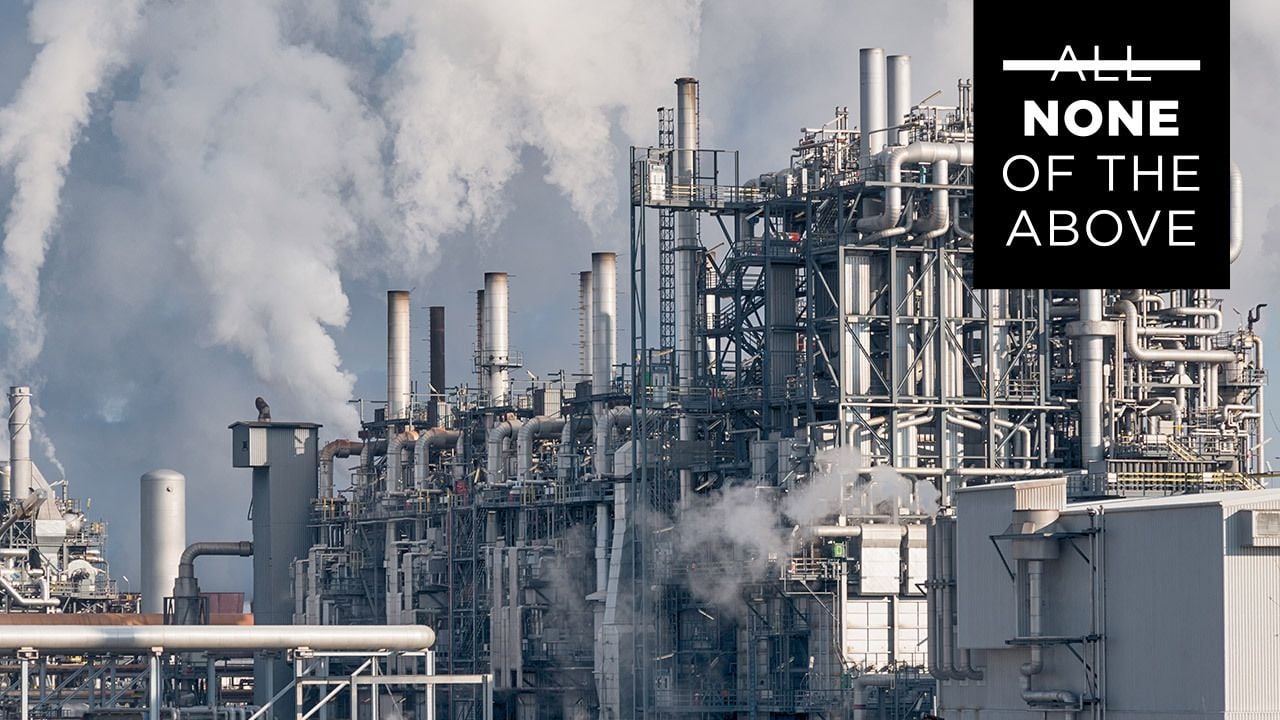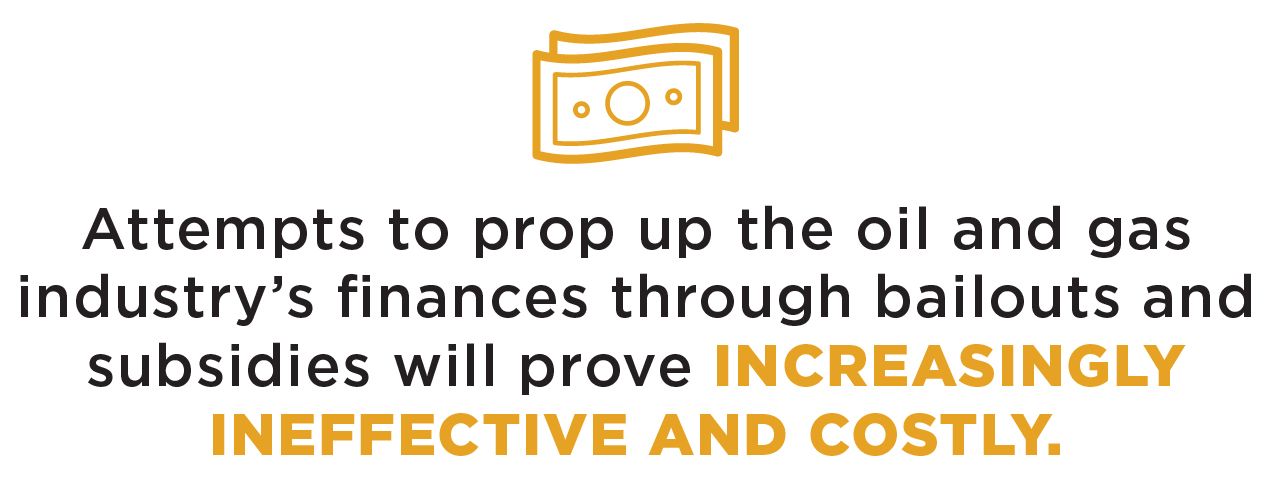
Third in a series.
The oil and gas industry, from extraction to transportation to refining, is no longer the profitable and financially stable enterprise it long was. Over the past decade, the industry’s profits have sagged, revenues and cash flows have withered, bankruptcies have abounded, stock prices have fallen, massive capital investments have been written off as worthless and fossil fuel investors have lost hundreds of billions of dollars.
These financial pressures are set to intensify over the coming decade, as the oil and gas sector faces the reality of the world’s transition to clean energy.
- Renewable power is getting cheaper and more abundant, eating into fossil fuels’ market share.
- Rising electric vehicle sales, improving energy efficiency and increased plastics recycling will further crimp oil and gas demand.
- New technologies will make some uses of fossil fuels obsolete.
- All the while, the world’s governments face a growing imperative to avert the most severe impacts of the climate crisis.
These trends will reinforce one another: For example, as wind and solar costs fall, some governments will set more ambitious goals to reduce emissions.
As these forces gather momentum, attempts to prop up the oil and gas industry’s finances through bailouts and subsidies will prove increasingly ineffective and costly. In fact, fossil fuel subsidies could ultimately harm consumers and the economy at large by slowing the transition to cheaper wind and solar power.
A troubled business model
For decades, the oil and gas industry’s business model hinged on the idea that fossil fuel consumption would rise in lockstep with global economic growth. As demand grew, oil markets would go through periods of tight supply and high prices, and oil companies would use the resulting cash bonanza to reward investors and secure additional oil and gas reserves to ensure future growth.

Ironically, the fracking boom in the U.S. oil and gas industry helped to break this business model. Rapid U.S. production growth – first of gas, then of oil – led to overabundant supplies and long periods of low prices and weak cash flows. As supply constraints eased, oil and gas reserves, once seen as the key source of long-term value for the industry, started to lose their financial relevance, as some companies admitted that vast hydrocarbon deposits were no longer profitable to develop.
These trends began long before the Covid-19 pandemic crippled the global economy. The pandemic merely exacerbated a financial decline that was already long underway:
- Since 2010, the stock values of the four largest oil and gas firms have plummeted by more than half.
- In five of the past seven years the oil and gas industry ranked last among all sectors of the S&P 500, falling to less than 3 percent of total value of the index at the end of 2020. This is a far cry from the 16 percent a decade ago and 30 percent a few decades earlier.
- Since 2015, industry analysts Haynes and Boone have listed nearly 800 exploration and production, oilfield services and midstream oil and gas companies that have filed for bankruptcy, with a debt load of more than $300 billion.
- 2020 saw $145 billion in write-downs of oil reserves and related assets, reflecting the diminishing value of the oil and gas sector.
The companies at the center of the U.S. fracking boom have fared worse than most other segments of the industry, consistently spending more on drilling and production than they generated by selling oil and gas. According to The Wall Street Journal, large publicly traded oil and gas producers spent $1.18 trillion on drilling and pumping oil over the past decade, largely on fracking, while bringing in only $819 billion. To stay afloat, many oil and gas companies took on substantial debt, setting the stage for subsequent bankruptcy filings and debt write-downs.

The diversified oil majors have seen similar trends. The globe’s five largest oil and gas companies – ExxonMobil, BP, Chevron, Total and Shell – rewarded stockholders with $561 billion in dividends and share buybacks over the last decade, while generating just $325 billion from their core business operations. To cover these deficits, the oil majors sold off $230 billion in oil and gas assets, while taking on $168 billion in additional long-term debt.
The industry’s financial instability has also led to job insecurity for its workers. The financial consulting firm Deloitte notes that the industry’s up-and-down employment cycle is becoming more volatile: Since 2014, a mere $1 per barrel change in oil prices can mean 3,000 jobs.
According to Deloitte, after a boom period leading up to 2014, industry employment plummeted by 200,000 jobs in two years, and during the pandemic the sector shed more than 100,000 jobs in five months.
Headwinds: new technology, climate policies
The oil and gas sector remains vulnerable to a continuation of the boom-and-bust cycles that have undermined its financial stability over the past decade. But against this backdrop, the industry now faces growing threats it is powerless to control. The signs of this transition are too strong to ignore:
- Electric vehicles are nearing cost parity with conventional autos, as battery prices continue to decline. Automakers have announced $250 billion in EV investments by 2023, and EV market share continues to rise in key European and Asian markets.
- The consulting firm McKinsey estimates that half of fuel burned to generate heat for industrial processes, where natural gas, coal and oil are used, can be replaced with electrification.
- Clean energy portfolios of wind, solar, battery storage and energy demand response are threatening the economics of natural gas power plants.
- Some analysts project that, within a decade, green hydrogen – made by electrolyzing water using renewable power – could become competitive with hydrogen produced from natural gas. Applications include the electric sector for long-term storage, long-haul transportation (semi-trucks and shipping) and industrial heat operations.
- Numerous U.S. cities are banning expansion of local natural gas networks in an effort to electrify buildings to meet climate goals.
- State climate policies have led to the cancellation of major natural gas pipelines along the East Coast.
What’s more, investors are becoming increasingly concerned about financial risks associated with climate change. Long-term investment patterns show a clear shift from fossil fuels to clean energy. For example, one stock portfolio of 30 renewables companies increased almost four-fold since 2014, while a similar fund consisting of 56 fossil fuel companies fell 17 percent.
These trends appear here to stay. The investment advisory firm Morrow Sodali surveyed 41 institutional investors last year that collectively manage over $25 trillion. All indicated that sustainability, social and government risks were at the top of their lists, with 86 percent naming climate change as the greatest risk. More than 90 percent identified climate as a top sustainability risk.

These developments do not bode well for the oil and gas industry, which has historically relied on expanding oil usage and has been slow to respond to the new technological, investment and policy reality.
Another sign of increasing financial instability within the industry is that, despite billions of dollars in windfalls from the Trump tax cuts and additional billions directed to the industry in the 2020 stimulus package, the industry’s poor financial position has barely changed.
Rising oil prices have lifted energy stocks from last year’s lows but remain far below their levels from a decade ago. With Wall Street coffers largely closed to the oil and gas sector, most companies have been forced to cut capital spending, presaging stagnating U.S. production and falling employment in the sector. Early data suggests that within the first few months of this year, the industry shed any of last year’s jobs gains.
Clark Williams-Derry is an energy finance analyst at the Institute for Energy Economics and Financial Analysis. Grant Smith is senior energy policy advisor at EWG.
IEEFA. “Living Beyond Their Means: Cash Flows of Five Oil Majors Can’t Cover Dividends, Buybacks.” January 2020. https://ieefa.org/wp-content/uploads/2020/01/Living-Beyond-Their-Means-Five-Oil-Majors-Cannot-Cover-Dividends_January-2020.pdf
IEEFA. “Shale Producers Spilled $2.1 Billion in Red Ink Last Year.” March 2020. https://ieefa.org/wp-content/uploads/2020/03/Shale-Producers-Spilled-2.1-Billion-in-Red-Ink-Last-Year_March-2020.pdf
IEEFA. “U.S. Frackers Slash Capital Investment to Lowest Level in Over a Decade.” December 2020. http://ieefa.org/wp-content/uploads/2020/12/US-Frackers-Slash-Capital-Investment-to-Lowest-Level-in-Over-a-Decade_December-2020.pdf
IEEFA. “IEEFA: After a terrible 2020, the oil industry’s story has turned political.” January 2021.
https://ieefa.org/after-a-terrible-2020-the-oil-industrys-story-has-turned-political/
IEEFA. “Running on Fumes: Oil and Gas Supermajor Cash Woes Worsened in 2020.” March 2021. http://ieefa.org/wp-content/uploads/2021/03/Running-on-Fumes-Oil-and-Gas-Supermajor-Cash-Woes-Worsened-in-2020_March-2021.pdf
IEEFA. “Capital markets are shifting decisively towards cleaner investments.” February 2021. https://ieefa.org/capital-markets-are-shifting-decisively-towards-cleaner-investments/
David Victor and Engine No. 1. “Energy Transformations: Technology, Policy, Capital and the Murky Future of Oil and Gas.” March 2021. https://reenergizexom.com/wp-content/uploads/2021/03/Energy-Transformations-Technology-Policy-Capital-and-the-Murky-Future-of-Oil-and-Gas-March-3-2021.pdf
Haynes and Boone. “Energy Bankruptcy Reports and Surveys.” December 2020. https://www.haynesboone.com/publications/energy-bankruptcy-monitors-and-surveys
The Wall Street Journal. “Wall Street Tells Frackers to Stop Counting Barrels, Start Making Profits.” December 2017. https://www.wsj.com/articles/wall-streets-fracking-frenzy-runs-dry-as-profits-fail-to-materialize-1512577420
The Wall Street Journal. “Frackers Scrounge for Cash as Wall Street Closes Doors.” June 2019.
https://www.wsj.com/articles/frackers-scrounge-for-cash-as-wall-street-closes-doors-11559915320
The Wall Street Journal. “Coronavirus Threatens to Hobble the U.S. Shale-Oil Boom for Years.” May 2020. https://www.wsj.com/articles/coronavirus-threatens-to-hobble-the-u-s-shale-oil-boom-for-years-11590312601
Deloitte Insights. “The future of work in oil, gas and chemicals.” October 2020. https://www2.deloitte.com/us/en/insights/industry/oil-and-gas/future-of-work-oil-and-gas-chemicals.html
Alliance for Automotive Innovation. “Unified Auto Industry Pledges to Work with Biden Administration on Establishing National Program to Reduce Greenhouse Gas Emissions.” February 2021. https://www.autosinnovate.org/posts/press-release/statement-on-greenhouse-gas-emissions
The Guardian. “Electric vehicles close to ‘tipping point’ of mass adoption.” January 2021. https://www.theguardian.com/environment/2021/jan/22/electric-vehicles-close-to-tipping-point-of-mass-adoption
McKinsey & Company. “Plugging in: What electrification can do for industry”. May 2020. https://www.mckinsey.com/industries/electric-power-and-natural-gas/our-insights/plugging-in-what-electrification-can-do-for-industry
Rocky Mountain Institute. “The Growing Market for Clean Energy Portfolios.” 2019. https://rmi.org/insight/clean-energy-portfolios-pipelines-and-plants
PV Magazine. “Green hydrogen to reach price parity with grey hydrogen in 2030.” July 2020. https://www.pv-magazine.com/2020/07/16/green-hydrogen-to-reach-price-parity-with-grey-hydrogen-in-2030/
Bailout Watch. “Bailed Out & Propped Up: U.S. Fossil Fuel Pandemic Bailouts Climb Toward $15 Billion.” November 2020. https://report.bailoutwatch.org/


